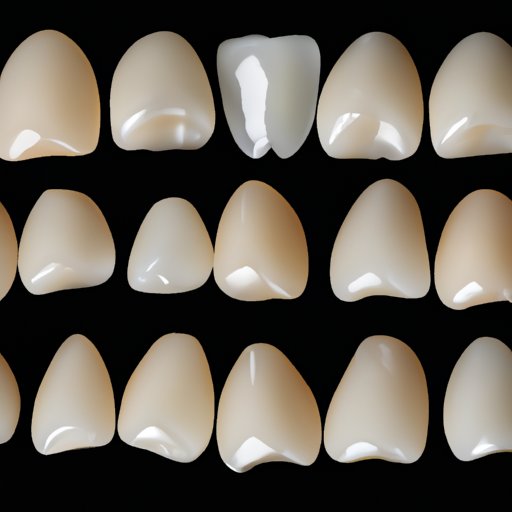
I. Introduction
Crowns are dental restorations designed to improve the function and appearance of damaged or decayed teeth. Many people who have dental crowns wonder whether they can whiten them along with their natural teeth. With so much conflicting advice online, it can be tough to know where to start. This article will explore the ins and outs of teeth whitening with crowns, offering practical tips and insights from dental professionals to help you achieve a brighter, healthier smile.
II. The Do’s and Don’ts of Teeth Whitening: What You Need to Know About Whitening Your Natural Teeth and Crowns
Before diving into the specifics of whitening dental crowns, it’s essential to understand the basics of teeth whitening in general. Teeth whitening is a cosmetic procedure that uses a bleaching agent to remove surface stains and lighten the color of teeth.
If you’re considering teeth whitening, it’s crucial to consult with a dental professional first. Whitening can be harmful to your teeth and gums if not done safely and correctly, which is why it’s essential to seek guidance from a dentist.
When it comes to whitening natural teeth versus crowns, there are some key differences to be aware of. Crowns are made from a variety of materials, including ceramic, porcelain, and metal. Unlike natural teeth, crowns don’t respond to whitening treatments by changing color. Bleaching agents, such as hydrogen peroxide, have no effect on the color of dental crowns. Attempting to whiten crowns can result in uneven coloration and damage to the restoration.
However, you can still whiten your natural teeth safely and effectively even if you have dental crowns. A professional dental cleaning can help remove surface stains and improve the appearance of your teeth. You can also consider using over-the-counter whitening products like whitening strips or gels, but be sure to check with your dentist before doing so.
III. Navigating Teeth Discoloration: Understanding the Limitations of Whitening Procedures on Crowns
While you can’t whiten crowns, there are still many options for achieving a brighter smile. It’s helpful to understand the limitations of whitening procedures and how they can impact crowns differently than natural teeth.
Different types of dental crowns can impact the whitening process. For example, ceramic and porcelain crowns tend to show less discoloration over time than metal crowns. Additionally, crowns that are located in the back of the mouth may be more prone to staining from food and drink.
There are risks associated with attempting to whiten dental crowns, including damage to the crown and surrounding tooth structure, uneven coloration, and increased sensitivity. If you’re concerned about the appearance of your crowns, speaking with a dental professional about alternatives like veneers or replacement crowns may be a better option.
IV. The Lowdown on Crowns: Debunking Myths About Whitening and Maintenance
There are many misconceptions about dental crowns and their maintenance. Some people believe that crowns are indestructible and don’t require any special care. However, dental crowns still require regular brushing and flossing to prevent decay and gum disease.
It’s also important to avoid habits that can damage or discolor your crowns, such as chewing on hard objects like pens, opening packages with your teeth, and consuming staining foods or drinks like coffee, red wine, and blueberries. Using a straw when drinking can help minimize contact with your teeth and crowns, reducing the likelihood of staining over time.
V. A Candid Conversation About Teeth Stains: Tips for Maintaining a Radiant Smile with Crowns
Teeth stains can be a frustrating and embarrassing problem for many people, even those with dental crowns. The good news is that there are many practical steps you can take to minimize stains and maintain a white smile.
One of the most effective ways to prevent teeth stains is by making dietary changes. Foods and drinks that are high in pigments, such as tea, coffee, red wine, and dark berries, are more likely to stain teeth. Reducing your consumption of these items or rinsing your mouth with water after consuming them can help minimize staining over time.
At-home oral care routines are also essential for maintaining a clean and white smile. Regular brushing, flossing, and using mouthwash can help reduce plaque and surface stains. Using a whitening toothpaste or gel can also help minimize discoloration, although it’s important to check with your dentist before trying any new products.
VI. The Truth About Crowns and Stains: Professional Opinions on Whitening and Alternatives
Seeking guidance from a dental professional is essential when it comes to maintaining good oral health and achieving a radiant smile. Professional teeth cleanings can help remove surface stains and improve the appearance of your teeth and crowns.
If you’re concerned about the appearance of your crowns and want to explore alternative options, dental veneers may be a viable option. Veneers are custom-made shells that fit over your existing teeth, providing a natural-looking and long-lasting solution for a brighter smile.
VII. Conclusion
While you can’t whiten dental crowns, there are still many options available for achieving a healthy, bright smile. Consulting with a dental professional about alternative treatments, practicing good oral hygiene habits, and making dietary changes can all help minimize stains and improve the appearance of your teeth and crowns.
Remember, it’s important to seek guidance from a dental professional before attempting to whiten your teeth or crowns on your own. With the right care and maintenance, you can achieve a beautiful, healthy smile that you’re proud to show off.




